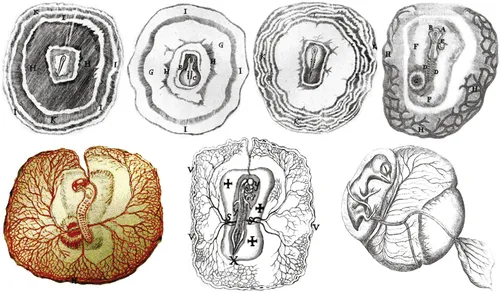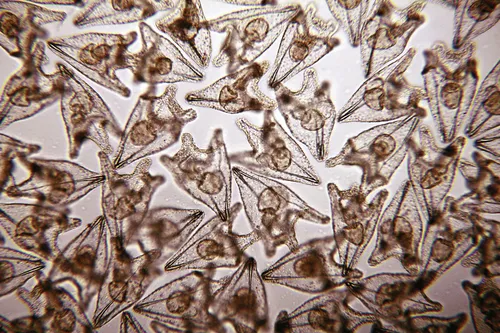
This is a test
- 460 pages
- English
- ePUB (mobile friendly)
- Available on iOS & Android
eBook - ePub
Book details
Book preview
Table of contents
Citations
About This Book
Genomic Control Process explores the biological phenomena around genomic regulatory systems that control and shape animal development processes, and which determine the nature of evolutionary processes that affect body plan. Unifying and simplifying the descriptions of development and evolution by focusing on the causality in these processes, it provides a comprehensive method of considering genomic control across diverse biological processes.
This book is essential for graduate researchers in genomics, systems biology and molecular biology seeking to understand deep biological processes which regulate the structure of animals during development.
- Covers a vast area of current biological research to produce a genome oriented regulatory bioscience of animal life
- Places gene regulation, embryonic and postembryonic development, and evolution of the body plan in a unified conceptual framework
- Provides the conceptual keys to interpret a broad developmental and evolutionary landscape with precise experimental illustrations drawn from contemporary literature
- Includes a range of material, from developmental phenomenology to quantitative and logic models, from phylogenetics to the molecular biology of gene regulation, from animal models of all kinds to evidence of every relevant type
- Demonstrates the causal power of system-level understanding of genomic control process
- Conceptually organizes a constellation of complex and diverse biological phenomena
- Investigates fundamental developmental control system logic in diverse circumstances and expresses these in conceptual models
- Explores mechanistic evolutionary processes, illuminating the evolutionary consequences of developmental control systems as they are encoded in the genome
Frequently asked questions
At the moment all of our mobile-responsive ePub books are available to download via the app. Most of our PDFs are also available to download and we're working on making the final remaining ones downloadable now. Learn more here.
Both plans give you full access to the library and all of Perlego’s features. The only differences are the price and subscription period: With the annual plan you’ll save around 30% compared to 12 months on the monthly plan.
We are an online textbook subscription service, where you can get access to an entire online library for less than the price of a single book per month. With over 1 million books across 1000+ topics, we’ve got you covered! Learn more here.
Look out for the read-aloud symbol on your next book to see if you can listen to it. The read-aloud tool reads text aloud for you, highlighting the text as it is being read. You can pause it, speed it up and slow it down. Learn more here.
Yes, you can access Genomic Control Process by Isabelle S. Peter,Eric H. Davidson in PDF and/or ePUB format, as well as other popular books in Biological Sciences & Genetics & Genomics. We have over one million books available in our catalogue for you to explore.
Information
Chapter 1
The Genome in Development
Abstract
Development is encoded in the genome by sequence-specific regulation of gene expression. In this chapter, we consider three major levels at which gene expression is controlled, with respect to their roles in the developmental process. The first is transcriptional regulation by sequence-specific transcription factors and their interaction with cis-regulatory modules. Secondly, micro RNAs modulate transcript prevalence, and a third level operates by means of chromatin modifications installed upon transcription factor–DNA interactions. While the expression of many genes is affected successively by all these mechanisms, the control of developmental complexity by means of spatially differential gene expression is executed by transcription factors and their sequence-specific interactions with the regulatory genome. Therefore, the primary key to the informational process of development lies in the control system regulating the expression of genes encoding transcription factors.
Keywords
Chromatin modifications; Genomic control of development; Noncoding RNAs; Regulatory genomics; Transcriptional control systems1. Views of Development
Considered from an informational perspective, the most interesting and defining feature of animal development is that it generates a continuous increase in complexity of spatial organization. Our early predecessors, from Aristotle to Caspar Friedrich Wolff, perceived this externally, remarking explicitly on the developmental increase in observed morphological complexity, the progressive appearance of more and more complicated body parts. This unique, and for centuries fundamentally mysterious, aspect of development is what struck every thoughtful observer. It is illustrated in Malpighi’s beautiful seventeenth-century drawings of chick embryogenesis reproduced in Fig. 1.1 (Malpighi, 1673, 1686), where the growing multiplicity of anatomical features as development progresses is carefully indicated.
Developmental increase in spatial complexity can today easily be perceived and measured in any degree of detail, at any underlying level: as developmental control of spatial gene expression, as progressive definition of regulatory gene expression patterns, and as diversification of cellular function in space. These phenomena all depend directly on the spatially mandated regulation of genes, ultimately thousands of them in any given developmental process. Developmental complexity is the direct output of the spatially specific expression of particular gene sets and it is at this level that we can address causality in development. Thus we come to our starting point. Increasing spatial complexity of gene expression directly requires continuing regulatory informational input, and conversely, the complexity of the developing organism is at root defined by these informational requirements.

Figure 1.1 Malpighi’s early demonstration of increasing organismal complexity in development of the chick embryo.
Marcello Malpighi’s drawings of a developing chick embryo, according to his own microscopic observations, are reproduced from his 1686 Opera Omnia, except for the dorsal view in color which was published by him in 1673 in Dissertatione Epistologica de Formatione Pulli in Ovo.
To view development as the output of informational transactions provides a unifying principle. Its application permits any aspect of the marvelous and diverse phenomena of development to be considered through the same lens. It took the whole of the twentieth century to arrive at an unequivocal appreciation of the fact that the information encoding development is located in the genomic sequences carried in the chromosomes of every cell of the organism (we briefly recap the major milestones along the intellectual way below). Now we have at last attained a framework view of what the genomic control system is, and how it operates.
Many logical spokes of the phenomenological wheel lead inexorably to the genomic regulatory code at its hub. For example, one might start by trying to explain how it could work that frogs beget frogs and dogs beget dogs, and never does one sort of animal produce an embryo that develops into another. There is no escape from the conclusions, first, that each sort of animal possesses a heritable, hence genomic, set of instructions for building the body plan of its own sort; second, that the genomic program suffices to direct the developmental construction of that body plan; it cannot depend on the environment or on magic hormones, or anything else not originating internally in the inherited genome. Or one might consider how it can be that every developing embryo of a given species has exactly the same major parts, in the same spatial relations to one another, executing the same functionalities. If we look for instance at a random field of nearly identical sea urchin larvae of the same age, as shown in Fig. 1.2, it is impossible to escape the implication that the same instructional program has operated to produce each individual. Therefore, again, such programs must exist; they must be identically replicated, hence genomic; and they must suffice to control the nature of developmental events independently and similarly in each organism. But though perhaps more subtle, the most revealing and powerful insight is implied by that unique phenomenological feature of development earliest noticed, the continuing increase in organismal complexity, however that be assessed. This tells us something profound about the nature and use of the developmental regulatory program. It means that it is capable of applying the state it has produced at each stage of development, in every cell, as inputs to formulate new states for the next stage, and the same again for the next stage after that. Since complexity increases, more cells are made to do more diverse things at each stage. But since they always do the right thing for that species, the states at Stage X not only have to be “read” in a given way, but in addition the right, specific, responses have to be installed at Stage X + 1, instructions for which also have to be written in the program. Thus the preexistence of a genomic regulatory program is directly implied by the increase in output complexity during development. This program includes the information to read the regulatory situation at each point in time everywhere in the organism throughout development, and to utilize these newly assessed data to generate the specific new situations needed for developmental progress in exactly the correct manner. It must operate from egg to adult form, integrating over all states and all spatial elements. It is thus no wonder that the regulatory genome used for development includes such an enormous amount of information, as we summarize below.

Figure 1.2 Identical operation of the developmental program: a field of 72h sea urchin larvae.
The larvae are from a single batch of fertilized eggs of Strongylocentrotus purpuratus, visualized at 72h. Each contains about 1800 cells, organized canonically individual to individual into differentiated tissues; embryogenesis is now complete and the larvae are about to commence feeding.
Development produces the genomically encoded body plans of animals, and evolution is the process by which body plans arise de novo, and heritably alter in deep time. Since causality in development must at root be considered in terms of information processing, and how spatial control of gene expression is mandated by genomic regulatory information, so also the evolution of the body plan. At the informational level of the genomically encoded program for development, evolutionary process is equivalent to the time derivative of developmental process: evolution is change in this same program over deep time (Peter and Davidson, 2011). That is, new morphological forms, new appendages, new central nervous system structures, and newly positioned skeletomuscular systems, arise in evolution by mutational alteration of preexistent developmental programs. Not only is evolutionary process in this specific mechanistic sense derivative of the developmental process, but, as we examine in the final chapter of this book, the structure/function rules that apply to the genomic developmental program also determine the effects of changes that cause evolutionary alterations in outcome. Thus from an informational point of view, no longer can there be any but artificial or arbitrary distinctions separating causality in evolution and causality in development. These areas of bioscience indeed have entirely different historical origins and evidential bases, such as paleontological data on the one hand and cell biological functions on the other. But they are directly convergent at the genomic regulatory information system that controls development.
How the developmental regulatory system works, at the individual gene level and the circuit level, are subjects we are concerned with throughout this book. Development cannot be explained in terms of the regulation of individual genes considered one by one, no matter how complex their regulatory apparatus, nor how important their particular roles. The major informational transactions underlying progressive developmental process control the orchestration of gene expression. This function is executed by gene regulatory circuits encoded in multiple genomic regulatory sequences. Operating in a modular manner according to their architecture, circuits powerfully enhance the regulatory potentiality of the control system in a large number of ways: for example, they provide the opportunity of coordinately controlling multiple genes, positively or negatively in diverse cells; they mediate system responses to outside signals; they are capable of producing diverse alternative outputs under different input circumstances; certain circuits respond sharply in different ways to graded input levels; others generate diverse dynamic behaviors.
Developmentally controlled expression of confined gene sets determines the identity, fate, and function of the fields of cells from which body parts develop, and of their progressively restricted subdomains. Spatially organized gene expression ultimately defines all individual cell types constituting the resulting body part or organ. The essential control feature in this process is thus the regulation of gene expression in time and space in order to accomplish the diversification of cell fates in development. Thus developmental complexity is a function of spatially controlled gene expression. Since all gene expression is initially regulated by transcription factors and their sequence-specific interaction with regulatory DNA, we can consider the control of expression of those genes that encode transcription factors to be the key and fundamental regulatory mechanism causal to the development of body plans. However, as we now know, gene expression is affected at many successive levels downstream of the primary transcriptional control mechanisms, including the regulation of mRNA levels by microRNAs (miRNAs), and the roles of chromatin modifications and long noncoding RNAs (lncRNAs) in gene expression. What is their contribution to the ultimate regulated gene output? Which of these will have to be considered to understand control of spatial gene expression in development? Before we take up larger systems of developmental gene regulatory interactions in the following chapters, we turn to the particular roles of each of these regulatory mechanisms in the genomic control of spatial gene expression.
2. Levels of Control of Gene Expression: Transcriptional Regulation
Though mechanistic aspects of the transcriptional regulatory sy...
Table of contents
- Cover image
- Title page
- Table of Contents
- Copyright
- About the Authors
- Preface
- Chapter 1. The Genome in Development
- Chapter 2. Gene Regulatory Networks
- Chapter 3. Genomic Strategies for Embryonic Development
- Chapter 4. Genomic Control Processes in Adult Body Part Formation
- Chapter 5. Genomic Strategies for Terminal Cell Fate Specification
- Chapter 6. On the Modeling of Developmental Gene Regulatory Networks
- Chapter 7. Evolution of Bilaterian Animals: Processes of Change and Stasis in Hierarchical Developmental Gene Regulatory Networks
- Gene Index
- Subject Index